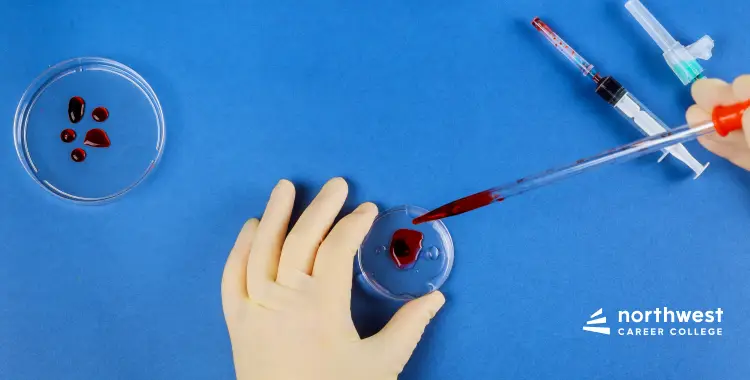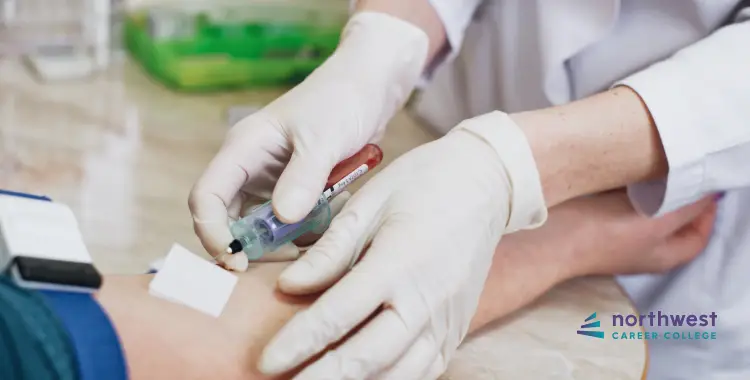Top 5 Challenges in Venipuncture and How to Overcome Them
- November 14, 2025
- 1.7k views
- 4 min read
Drawing blood may sound easy, but venipuncture has its challenges. Every time you practice as a phlebotomy technician, each blood draw would be different considering different veins, emotions, and medical conditions.
Knowing the challenges a phlebotomy professional will face and ways to curb them will fully prepare you for your career. Let’s closely examine the top five challenges in venipuncture and some good ways that can help you circumvent or overcome them.

Table of Contents
Finding Difficult Veins
The inability to locate hidden veins is one of the most common complications of venipuncture. The failure may be related to patients with small, deep, or collapsed veins.
Solution:
- Go Slow: Allow your finger to take a second and feel for that vein rather than rushing it.
- Use Appropriate Equipment: Smaller gauge or butterfly needles may allow access to more challenging veins.
- Ask the Patient: The experienced Patient may know which veins are best for blood draws.
A study involving 3,587 participants found that the first-attempt success rate for finding veins was 81%. The research identified five key factors influencing success, including a history of difficult intravenous access. Proper technique and practice can significantly improve success rates, especially for patients with chronic conditions or dehydration.
Anxiety Management in the Patient
Most patients fear needles, and that makes them tighten up or even faint; hence, the procedure may be quite tricky.
Solution:
- Clear Communication: Explain the process step by step and reassure the patient.
- Stay Cool: Your confidence can reduce your anxiety.
- Encourage Deep Breathing: This has the effect of relaxing the patients and reducing stress levels.
Being compassionate and patient-centered will help facilitate it to make things smooth and easier while building trust in the persons you try to help.
Minimizing Pain and Discomfort
Nobody likes the prick of a needle, and it is your job to make this process lessened, if not painless. Poor techniques can result in unnecessary discomfort that may be better given as a complaint or another attempt.
Solution:
- The needle angle and insertion method shall be appropriate.
- Warm up the area by dilating the veins, making the insertion smooth.
- The patient is distracted by talking or asking the patient to look away to minimize discomfort.
Most of this process can be painless, provided one practices and pays attention to detail.
Management of Disorders of Blood Flow
Sometimes, blood extraction starts well and becomes ultra-slow or grinds to a complete stop. Vein collapse, wrong positioning of the Needle, and excessive movement by a patient may contribute to that effect.
Solution:
- Move the Needle Gently: A slight adjustment will often resume the blood flow.
- Let off the Tourniquet: This will allow for a restoration of blood flow should a vein collapse.
- Hydrate: Ask patients to come in hydrated on the day of the appointment by drinking water to facilitate the visibility and flow of the veins.
Minor adjustments that may be necessary in either direction will negate the need to restart, keeping the Patient comfortable and the procedure’s efficiency intact.
5. Infection Control Safety
It is essential in the venipuncture procedure that infection is kept off, and for the protection of patients and technicians alike, sterile environments should be kept intact. Even minor infection safety lapses can have grave consequences.
Solution:
- Protocols to Be Followed: Use gloves sterile equipment, and properly dispose of the needles.
- Clean the Site Thoroughly: This is done using an alcohol swab for the site where the Needle will be inserted.
- Be Vigilant: Labels, tubes, and patient information will be cross-checked to eliminate mix-ups.
Conclusion
Though it can be complicated, with proper training and an accurate attitude, challenges within the venipuncture process shall be resolved to achieve astounding accomplishments in the particular field of interest.
Furthermore, Northwest Career College provides the desired practical skills. Phlebotomy Technician Programs put forward the potential to equip relevant individuals to manage some hurdles that come their way by gathering appropriate competence.
Enroll now and get started in this exciting and rewarding world of healthcare. For more information about our program or any other questions, please visit our website or contact us today.





